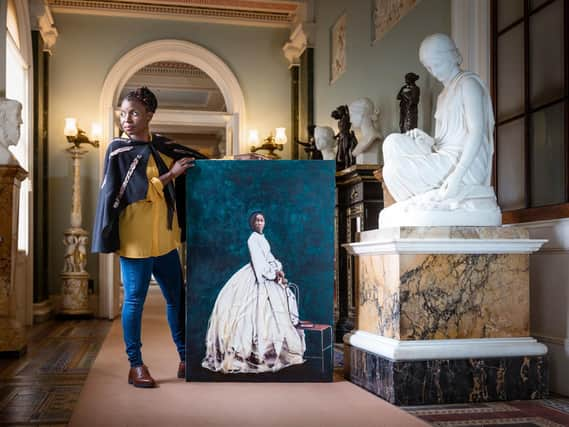English Heritage to reveal slave trade links as Hannah Uzor’s painting of Queen Victoria’s African goddaughter goes on display


The picture of Sarah Forbes Bonetta, the daughter of a West African ruler, is on show as part of a plan to feature portraits of “overlooked” black figures connected with English Heritage sites.
The charity has carried out in-depth research into the links between the slave trade and its numerous properties.
Advertisement
Hide AdAdvertisement
Hide AdFrom next year, information at sites, such as its country houses, will bring that information “to the fore”.
Properties where visitors will find new information about connections to the slave trade will include Brodsworth Hall in South Yorkshire.
The Brodsworth estate was bought in 1791 by Peter Thellusson, who provided loans and insurance to slave-ship and plantation owners.
His great-grandson Charles Sabine Thellusson (1822–85) was later granted the Brodsworth estate, after which he replaced with the old Georgian house.
Advertisement
Hide AdAdvertisement
Hide AdBonetta, who was orphaned and sold into slavery at the age of five, was presented as a “diplomatic gift” to Captain Frederick Forbes in 1850 and brought to England.
Captain Forbes had visited the King of Dahomey as a representative of Queen Victoria, on a mission to negotiate the suppression of slavery.
He named her Sarah Forbes Bonetta, partly after his ship, the HMS Bonetta.
Queen Victoria and Bonetta met several times after being introduced by the captain, including at Osborne, the monarch’s seaside home on the Isle of Wight, where the new portrait is now on display.
Advertisement
Hide AdAdvertisement
Hide AdQueen Victoria became godmother to the seven-year-old, whom she described as “sharp and intelligent”, and paid for her education by missionaries in Kent and Freetown, Sierra Leone.
Bonetta, who became an accomplished musician and linguist, later named her first daughter after the Queen, who also became the child’s godmother.
English Heritage said it would commission portraits of other historical black figures associated with its historic sites “and whose stories, like Bonetta’s, have been previously overlooked”.
The move comes after the National Trust revealed that 93 of the properties it looks after, including Winston Churchill’s Kent home Chartwell, have links to historic slavery and colonialism.
Advertisement
Hide AdAdvertisement
Hide AdCommons Leader Jacob Rees-Mogg later criticised the Trust for not realising “how wonderful” Churchill was.
Hannah Uzor’s painting of Bonetta – wearing her wedding dress – will be on show at Osborne House throughout October, Black History Month.
Uzor said Bonetta “challenges our assumptions about the status of black women in Victorian Britain”.
“To see Sarah return to Osborne, her godmother’s home, is very satisfying, and I hope my portrait will mean more people discover her story,” she said.
Advertisement
Hide AdAdvertisement
Hide AdPortraits to go on display next year will include Rome’s African-born emperor Septimius Severus, who strengthened Hadrian’s Wall, and James Chappell, a 17th century servant at Kirby Hall in Northamptonshire.